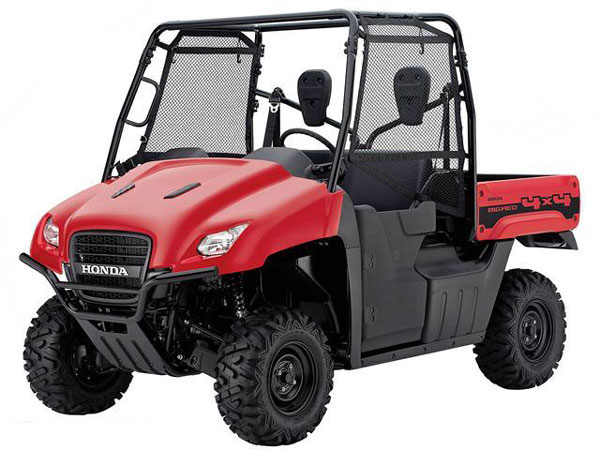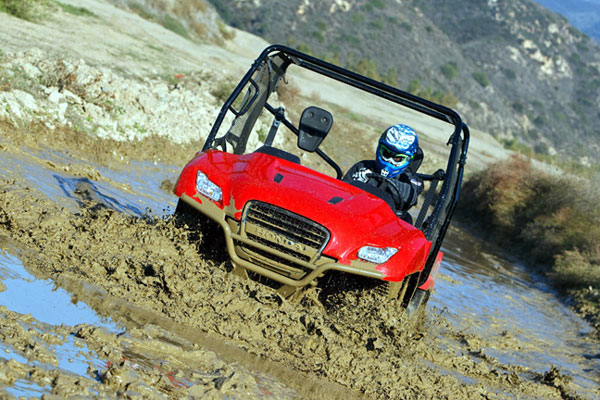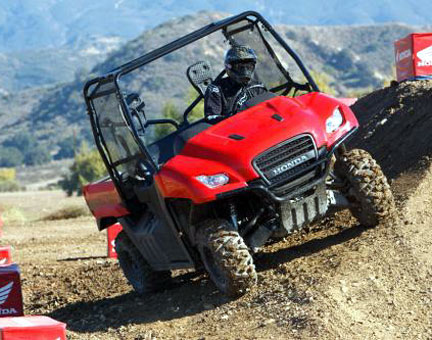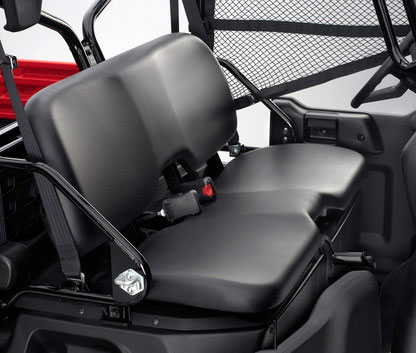UTV Review 2011 Honda Big Red
Honda’s Big Red Receives its First Update
by Jason Giacchino

We might as well come right out with it: the hot topic of the UTV industry of late has been performance. Side x Sides with long-travel suspension numbers, fire-breathing engines, and the ability to leave dune buggies in the dust have been earning the lion’s share of the press these days and we’re as guilty as the next by getting caught up in the hoopla.
However there are countless UTV buyers who purchase machines with intentions of work: towing, hauling, dragging and patrolling – with the occasional recreational outing thrown in for good measure. Just because models designed for this purpose haven’t been making headlines these days, it doesn’t mean the manufacturers have withdrawn their interest. In fact the 2011 Honda Big Red is proof of just the opposite, having benefited from its first makeover since the reintroduction of the legendary namesake.
What’s New for 2011?
Honda didn’t bother fixing areas which they didn’t think were broke, so the Big Red received updates in but few key areas, beginning with new graphical treatment and black wheels to match the black accents of the trim. The bucket seats have kicked the bucket in favor of a roomier bench seat, complete with a pair of inertia-locking seatbelts taken directly from Honda’s automotive division. The shocks have been revalved for a plusher ride, but with increased bottoming resistance; they have gained external preload adjusters on the rear as well.
Bed capacity has been doubled to 1,000-pounds (up from 500) and towing capacity has gone from a 1,200-pound limit to 1,500. Tires also have been upgraded with the original’s 2-ply Dunlops getting the boot by Maxxis Big Horn 4-ply units. Surprisingly the price for the MSRP for the new and improved Big Red is unchanged at ,699.

Providing the Power
A peek under the hood reveals a fuel injected 675cc liquid cooled single cylinder. While some were hoping Honda would follow suit in the recent tradition of multiple-cylinder configurations, keep in mind, Honda didn’t want to add unnecessary complexity or maintenance demands.
The Big Red does, however, retain its unique transmission. Bucking the trend of the CVT transmission found in virtually every other UTV on the market today, the Big Red once again dips into Honda’s vast automotive experience to incorporate an automotive three-speed fully automatic transmission. The bad news is that there is still no low-range option here.

Saddle Up
So the big question here is just what does it feel like to take control of the Big Red? If we were to summarize the experience into a single word – that word would be “refined”. Thanks to the automotive-inspired bench seat, seat belts and transmission, the Big Red feels the most polished of any UTV on the market. It accelerates with precision (even if the shifts are a bit more pronounced, especially to drivers used to CVTs) and really tends to take the guesswork out of the equation entirely.
At 60-inches wide, the Big Red feels, well, big. On tight trails it can sometimes come off as cumbersome, but do keep in mind that putting work before play is the Big Red’s forte, and in that regard it delivers in earnest. There is a rugged rigidity about the Honda that hints toward its willingness to labor. It may have just been us, but it really felt as though the Big Red was in its natural element in those instances where we had the bed loaded to the hilt, a trailer in tow and were crawling through the gooey farm trails of early spring.
However, we realize that a machine’s ability to work when asked to and play when the job is done ranks up there, so we certainly don’t wish to insinuate that the Big Red is little more than a 2-seater tractor. We found the top speed to hover around 40mph, which is plenty quick for most trail situations. Additionally the tweaked suspension seems better equipped to deal with traversing rough terrain at speed.
As funny as it sounds, the automotive style seatbelts actually go a long way toward maximizing the off-road experience, thanks to their ability to lock up when the driver or passenger move forward. This feature is pretty confidence inspiring during hard braking, fast cornering and when descending steep grades.
Not that traction was ever an issue with the original Big Red; we certainly felt a notable performance boost in the new tire spec, especially in the soupy mud that made-up 100% of our test conditions.

Odds & Ends
The Big Red’s massive physical dimensions may hinder it slightly in tight terrain, but they more than make up for it in terms of driver (and passenger) comfort. There is ample legroom for even the tallest operator, and we never felt like there was too little elbowroom between the driver and passenger. Couple this to Honda’s reputed fit and finish and what results is a vehicle that almost invites the urge to travel. Drivers who frequently cover a lot of ground in their UTV would be wise to consider Honda’s entry.
The preload adjusters in the back are a welcome addition as well and allow users to compensate for heavy bed loads. The bed itself tilts via a gas-charged damper; we found the feature extremely useful when hauling then depositing peat moss into a long flowerbed.
The doors are also well built, sturdy and close with automotive authority.

Complaint Department
Going into this review we had intentions of faulting the new Big Red for its lack of transmission ranges (and for that matter, even the ability to select and stay in any of the three gears at your disposal) but truthfully such objections never manifested in the real world. A lot like the automatic transmission in a modern SUV, there really isn’t much to complain about. Mud, goop, snow and slush are approached no differently than a well-groomed trail or grassy field; step on the throttle and let the Big Red handle the rest. We took it through some pretty nasty stuff and were unable to get it stuck.
We also found it odd that with such attention to detail shown throughout, Honda neglected to include a speedometer, and mounted the fuel gauge on the gas tank itself rather than in the cockpit. Slightly atoning for the latter is a low-fuel light on the dash. Other dash instrumentation includes a coolant temp light, check engine, neutral & reverse indicators, and 4WD.
Conclusion
The 2011 Honda Big Red is a versatile UTV and will serve well those who like to work their machine hard and reward its efforts with the occasional romp. Honda’s line of genuine accessories is rich enough to ensure that whatever equipment the Big Red lacks in stock trim (a winch for example) can be added later with full factory support.
Honda’s fit and finish are certainly present in the Big Red, and while its price tag actually places it in the higher end of the work-oriented UTV segment, we conclude opting for the Big Red is a sound allocation of funds.
Specs
Engine Type: OHV single-cylinder four-stroke
Engine Displacement: 675cc
Bore & Stroke: 102 mm x 82.6 mm
Compression Ratio: 9.2:1
Cooling: Liquid-Cooled Fuel System Electronic fuel injection (PGM-FI), 40mm throttle body
Ignition: Full-transistorized type with electronic advance
Starting: System Electric
Transmission: Automotive-style w/hydraulic torque converter; three forward gears and Reverse
Final Drive: Direct front and rear driveshafts
Rake and Trail: NA Wheel Base 75.7 in.
Front Suspension: Independent double-wishbone; 5.9-inch travel Rear Suspension: Independent double-wishbone; 7.1-inch travel with adjustable preload
Front Brake: 200mm hydraulic disc with 51.1mm caliper
Rear Brake: 200mm hydraulic disc with 30.3mm caliper
Front Tire: Maxxis Big Horn 25 x 10-12 bias
Rear Tire: Maxxis Big Horn 25 x 10-12 bias
Fuel Capacity: 7.9 Gallons, including 1.5-gallon reserve
Dry Weight: 1,433 lbs. (Wet)
MSRP: ,699
Contact
http://powersports.honda.com/offroad/muv.aspx
